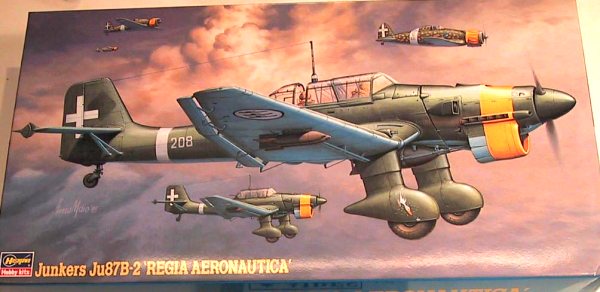
Hasegawa 1/48 Ju-87B2
| KIT: |
Hasegawa
1/48Ju87 B2 JT 176 Aries Ju87 Update # 4001 Eagle Strike 48021 Decals |
| PRICE: |
$45.00 Cdn
Kit and $30 for update |
| DECALS: |
One Aircraft |
|
REVIEW: PHOTOS : |
Ray Snazel |
| NOTES: | Good detail; requires extensive dry fitting and poor fit in places. |

|
HISTORY |

'Stuka' or 'Sturzkampfflugzeug' was the general German terminology for dive-bombers, but the Ju 87 with its inverted gull wing, and fixed-undercarriage was the most famous and feared of all. The Ju 87 was ugly, sturdy, accurate, but very vulnerable to enemy fighters; its use demanded air superiority. But its effectiveness in destroying fortifications or ships, or just scaring people, was undoubted. On the eastern front the last Ju 87 versions were employed as anti-tank aircraft with under wing 37mm guns. Over 5700 built.
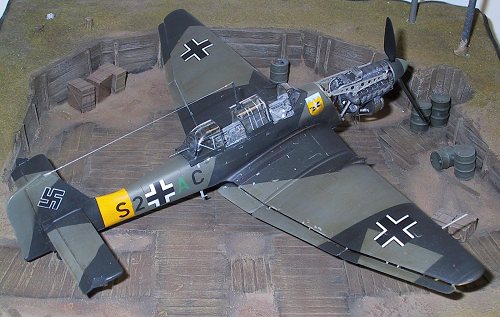 Berta (B) - The Berta evolved in an attempt to solve the problems discovered
in the disappointing performance of the Anton. The primary difference was the
installation of the Junkers Jumo 211 A engine, which was rated at 1,100hp. This
gave the Ju 87B the necessary power to be a truly effective dive-bomber. The
cowling was redesigned to allow for this installation and included the shifting
of several support systems and a larger, rounder radiator bath. Another feature
that was a completely redesigned of the landing struts. Gone were the ungainly
trousers and in there place were much more aerodynamically efficient spats. Also
introduced was an automatic pull-out device to prevent pilots that blacked out
during a being rudely awakened by an untimely impact into the terrain. Five Ju
87B-1's flew with the Condor Legion and completely eclipsed the Antons
performance, thus securing for itself a place in the RLM's tight production
schedule.
Berta (B) - The Berta evolved in an attempt to solve the problems discovered
in the disappointing performance of the Anton. The primary difference was the
installation of the Junkers Jumo 211 A engine, which was rated at 1,100hp. This
gave the Ju 87B the necessary power to be a truly effective dive-bomber. The
cowling was redesigned to allow for this installation and included the shifting
of several support systems and a larger, rounder radiator bath. Another feature
that was a completely redesigned of the landing struts. Gone were the ungainly
trousers and in there place were much more aerodynamically efficient spats. Also
introduced was an automatic pull-out device to prevent pilots that blacked out
during a being rudely awakened by an untimely impact into the terrain. Five Ju
87B-1's flew with the Condor Legion and completely eclipsed the Antons
performance, thus securing for itself a place in the RLM's tight production
schedule.
The Berta was
developed into several different versions including the Trop version used
by the Afrika Corps and the long ranged R version that was equipped with
"strap-on" fuel tanks. The Berta served with distinction in the Polish invasion
but revealed severe vulnerabilities a year later during the Battle of Britain,
forcing them to be withdrawn to theatres where the Luftwaffe enjoyed some sort
of air superiority. The Berta served throughout the war, mainly on the Eastern
front and with various air forces, including the Slovakian, Romanian, Hungarian
and Italy's Regia Aeronautica.
The Berta was also used as the basis for the C variant which was being developed as a carrier based dive bomber. The C variant was cancelled when it was realized that the Berta's airframe was obsolete.
|
THE KIT |
The kit is of standard Hasegawa quality nothing really fancy, just a good kit.
The instructions are clear and concise, the
sprues are clean and require only minimal cleanup. The decals are provided for
1 aircraft, as this particular kit was a repackage with decals for Sicily. The
Stuka is 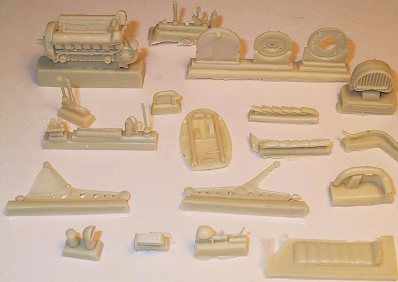 well documented on
the net and in many books. I chose the Eaglestrike decal set 48021 which
includes decals for 4 aircraft.
well documented on
the net and in many books. I chose the Eaglestrike decal set 48021 which
includes decals for 4 aircraft.
|
Aries Update |
This is my first crack at an Aries update, admittedly I am a Verlinden guy from 10 years ago. My first impression of the kit was WOW !! a ton of clean resin, photo etch is clean and easy to work with (see image to the right). I was so impressed that I orders 3 more updates instantly for future projects.. IMHO Verlinden has real competition in this area.
The kit includes a full cockpit replacement, full engine and firewall and is in a word awesome. I would find out later that it is also a ton of workÖ more on that later.
|
CONSTRUCTION |
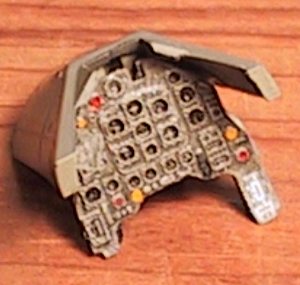 First up was the cockpit, my
favorite part. The update includes a floor and sidewalls, you have to smooth
the kits sidewalls to get the resin to fit, also thin the resin as far as you
dare so it will flex to the curvature of the fuselage. The best way I found to
get a good fit was to use epoxy and clamp the resin to the sidewall with the
flex intact. BE CAREFUL !! The floor is very straightforward and fits to the
sidewalls nicely. The only snafus with the cockpit was the oxygen bottle for
the rear gunner, be careful where you position it, to far forward and it
interferes with the radio panel installed later and to far back and the rear
seat wonít fit. My other beef is the rudder pedal assembly 3 very small and
thin pieces of photo etch bent in a million different positions, maybe I just
need smaller hand but I had trouble getting this to fit right, just beware. The
interior was painted RLM 02 with a black wash then dry brushed various shades of
grey. The instrument panel is nice, but I would recommend painting the back of
the film white to get the details to show through better, I like the effect I
ended up with.
First up was the cockpit, my
favorite part. The update includes a floor and sidewalls, you have to smooth
the kits sidewalls to get the resin to fit, also thin the resin as far as you
dare so it will flex to the curvature of the fuselage. The best way I found to
get a good fit was to use epoxy and clamp the resin to the sidewall with the
flex intact. BE CAREFUL !! The floor is very straightforward and fits to the
sidewalls nicely. The only snafus with the cockpit was the oxygen bottle for
the rear gunner, be careful where you position it, to far forward and it
interferes with the radio panel installed later and to far back and the rear
seat wonít fit. My other beef is the rudder pedal assembly 3 very small and
thin pieces of photo etch bent in a million different positions, maybe I just
need smaller hand but I had trouble getting this to fit right, just beware. The
interior was painted RLM 02 with a black wash then dry brushed various shades of
grey. The instrument panel is nice, but I would recommend painting the back of
the film white to get the details to show through better, I like the effect I
ended up with.
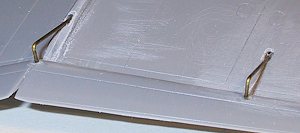 For the wings, pretty
straight forward but you must remove the ugly triangle molds on the flaps and
replace them with copper wire. Not big surgery but check out the results, much
more realistic. Watch the fit of the training edge of the wings, itís a bugger
to fix if it need sanding. A little time here will say hours later. When
fitting the wing to fuselage there are 2 areas to watch. The wing hits the
target window under the pilotís feet but nothing a file wont fix, the training
edge of the wing wont match the fuselage if you didnít sand the cockpit floor
enough. Of course I find this out after the fact so hopefully you wont make the
same mistake and idiot here.
For the wings, pretty
straight forward but you must remove the ugly triangle molds on the flaps and
replace them with copper wire. Not big surgery but check out the results, much
more realistic. Watch the fit of the training edge of the wings, itís a bugger
to fix if it need sanding. A little time here will say hours later. When
fitting the wing to fuselage there are 2 areas to watch. The wing hits the
target window under the pilotís feet but nothing a file wont fix, the training
edge of the wing wont match the fuselage if you didnít sand the cockpit floor
enough. Of course I find this out after the fact so hopefully you wont make the
same mistake and idiot here.
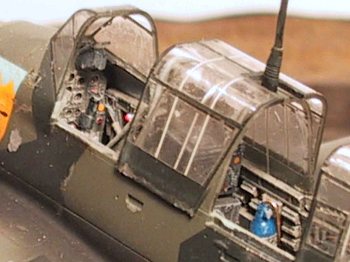 The fuselage with the update
added needs some attention. You will find the cockpit floor needs to be spread
for the wing root to fit on the top, thus messing up the training edge mentioned
earlier. You need to do this for kit part J26 to even come close to fitting.
Further surgery is required for the firewall installation but really
straightforward. The Aries instructions walk you through this efficiently. I
decided to move the elevators but if you do this get into the books because the
mass balance must be adjusted to match the elevator position. Similar with the
rudder positioning, the top is very thin so be cautious.
The fuselage with the update
added needs some attention. You will find the cockpit floor needs to be spread
for the wing root to fit on the top, thus messing up the training edge mentioned
earlier. You need to do this for kit part J26 to even come close to fitting.
Further surgery is required for the firewall installation but really
straightforward. The Aries instructions walk you through this efficiently. I
decided to move the elevators but if you do this get into the books because the
mass balance must be adjusted to match the elevator position. Similar with the
rudder positioning, the top is very thin so be cautious.
Before I forget, the stupid landing light I dropped inside the finished wing, it took 2 days to get it out, a lot of neat words came from the basement when I did thisÖ stupid fool.
The Canopy was coated in future floor wax to give a nice gloss, a lot of masking here but worth the effort. In hindsight I would have ordered the ez masks but I was to impatient to wait for the order.. next time.
|
PAINT & DECALS |
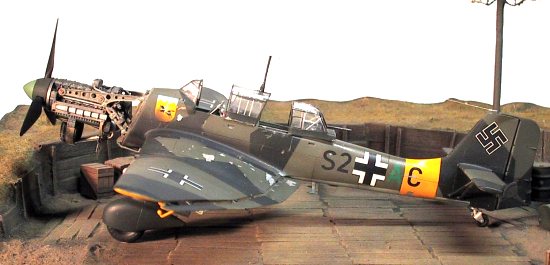
Not much here, simple RLM 65/70/71 with a lot of pastel weathering on the bottom, paint chips are from a undercoat of SNJ aluminum and pulling on the masking tape. RLM 25 on the spinner. Raw umber oil wash and some dry brushing to finish. Decals went on great, typical of Aeromaster.
I chose to do the aircraft flown by Gruppen Kommandeur Helmut Bode. Sevastapol Crimea Russia, June 1942. Helmet commanded 3/St.G 77 throughout the Battle of Britain and on into Barbarossa, the invasion of Russia. RLM 04 Gelg theatre ID bands on the wing tips and fuselage.
|
CONCLUSIONS |
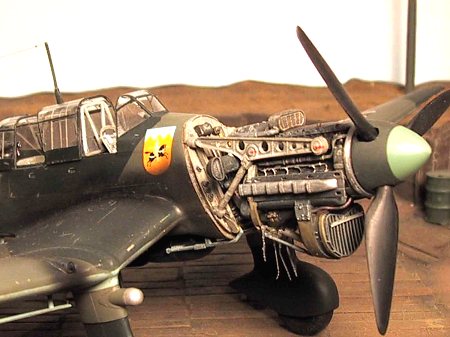 Great kit, lots of work but worth the effort, I placed the engine on last, a
small flat coat of Poly S and she was ready for the display case. A very
satisfying project, approx 100 hours to complete.
Great kit, lots of work but worth the effort, I placed the engine on last, a
small flat coat of Poly S and she was ready for the display case. A very
satisfying project, approx 100 hours to complete.
|
REFERENCES |
Eagle Strike 48021 Data Sheet.
Various online sources.
If you would like your product reviewed fairly and quickly, please contact me or see other details in the Note to Contributors.